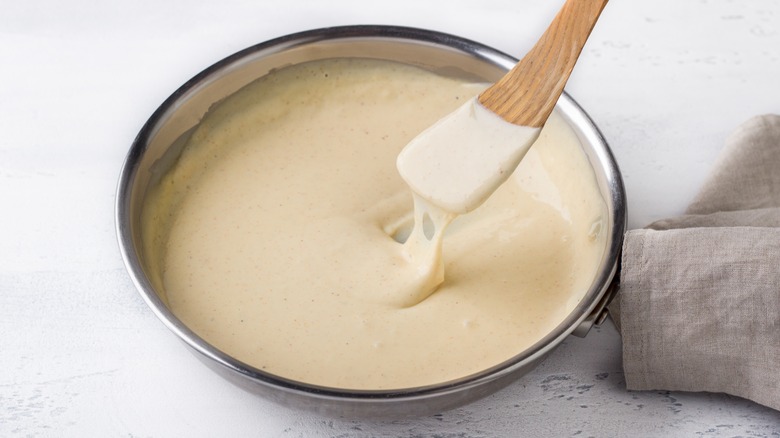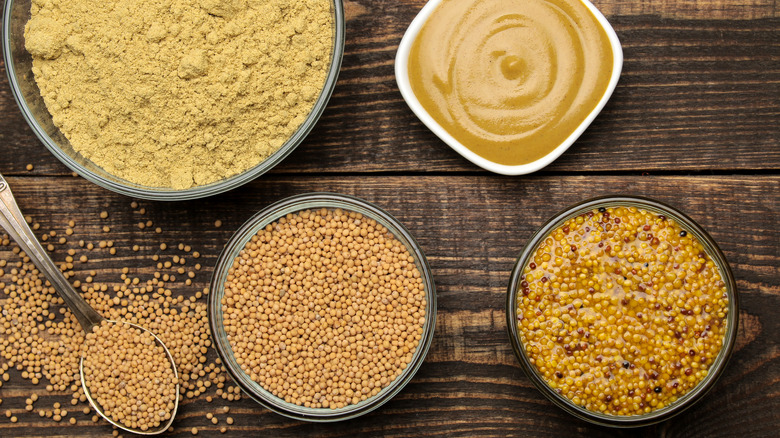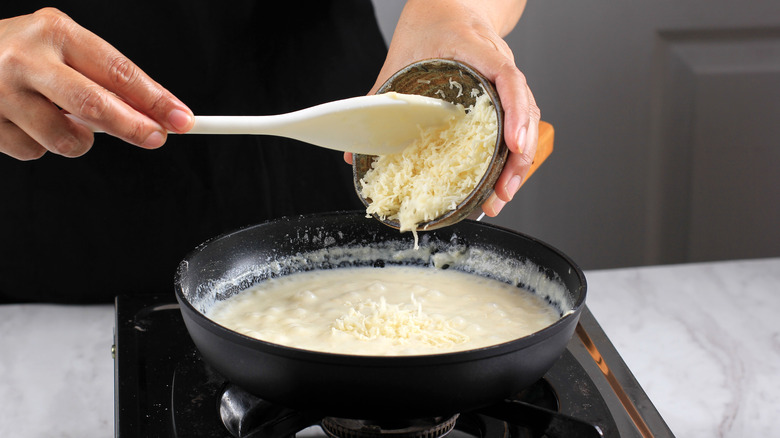The Ingredient You Need For Next-Level Béchamel Sauce
Out of the five mother sauces used in classical French cookery, béchamel is perhaps the most simple. Compared to its more complicated brethren — velouté, Espagnole, hollandaise, and tomato sauce — béchamel is made with just a few basic ingredients, namely melted butter and flour. This combo is whisked over heat to make a roux before it's thickened with hot milk. Don't be fooled by its simplicity, as the resulting luxurious and silky sauce is actually incredibly versatile.
You can use béchamel in all sorts of dishes, from macaroni and cheese to baked lasagna and chicken pot pie. It adds a creamy texture without any distracting flavors, but it's also a great base for making more assertive sauces by adding an extra ingredient or two. One of the easiest and tastiest additions has to be mustard. Just adding a bit of this acidic condiment lends a huge boost of flavor to a basic béchamel, while also helping to balance out its richness.
With a wide range of flavors, varying from mild and slightly creamy to fiery-hot, different types of mustard can all work well in béchamel, depending on your personal taste and the recipe you're making. Mustard béchamel is a quick and easy way to add extra depth of flavor to a variety of dishes, so the possibilities are only limited by your imagination.
Different mustards can give béchamel a kick
A French mustard from the city of the same name, Dijon mustard is a natural partner for béchamel. With ingredients like brown mustard seeds, white wine, and verjuice (a tart juice often extracted from grapes), the bright flavors in Dijon work especially well with creamy béchamel sauce.
Try adding a teaspoon of Dijon mustard to hot, freshly-made béchamel sauce and stirring it thoroughly before adding it to a homemade croque monsieur sandwich. The creamy yet tangy sauce pairs beautifully with the Gruyere cheese and deli ham in this French classic. A stronger English mustard will add more of a spicy kick to the sauce, and whole grain mustard can also be quite sharp, while adding some texture. Add a little of these at a time, tasting as you go, to avoid an overly strong sauce. A more assertive mustard béchamel is great with savory meats such as pork or lamb.
To keep things really simple, mix a teaspoon of dry mustard power with the flour you'll be using in the béchamel. Just add this dry mixture to a pan of hot butter to make the roux, then whisk in warm milk to make a creamy-yet-sharp mustard sauce to serve with chicken, fish, or vegetables. You can always add more of your favorite mustard to the béchamel after cooking, if you want a more robust taste.
Add other ingredients to elevate a basic béchamel
Not a fan of mustard? This condiment is not the only ingredient that can enhance a plain béchamel sauce. Adding additional flavors such as cheese or herbs to the basic sauce creates endless variations, which can be used in a vast array of recipes.
Adding shredded Gruyere, sharp cheddar, Swiss cheese, or Parmesan to béchamel makes for an easy Mornay sauce, the French name for a simple cheese sauce. Mornay is classically served with eggs and spinach in eggs Florentine, a variation on eggs Benedict. It's also perfect for an elevated mac and cheese, or a creamy, cheesy casserole with potatoes, meat, veggies, or any combination of these.
For extra-rich depth, try adding cooked onions to béchamel and pureeing the mixture to make a soubise sauce to go with steak or vegetables. Combining chopped fresh or dried herbs with béchamel will give it a fresher aroma that perks up chicken or fish. Or for something more elaborate, go for a Nantua seafood sauce, made by blending béchamel with crayfish or shrimp butter. While béchamel is deliciously rich and velvety as it is, it can truly shine as a base of customizable sauces.



